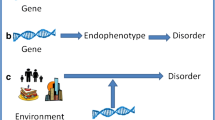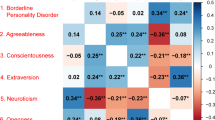Abstract
We review recent gene-environment studies relevant to borderline personality disorder, including those focusing on impulsivity, emotion sensitivity, suicidal behavior, aggression and anger, and the borderline personality phenotype itself. Almost all the studies reviewed suffered from a number of methodological and statistical problems, limiting the conclusions that currently can be drawn. The best evidence to date supports a gene-environment correlation (rGE) model for borderline personality traits and a range of adverse life events, indicating that those at risk for BPD are also at increased risk for exposure to environments that may trigger BPD. We provide suggestions regarding future research on GxE interaction and rGE effects in borderline personality.

Similar content being viewed by others
References
Papers of particular interest, published recently, have been highlighted as: • Of importance •• Of major importance
Lenzenweger MF, Lane MC, Loranger AW, Kessler RC. DSM-IV personality disorders in the national comorbidity survey replication. Biol Psychiatry. 2007;62:553–64.
• Trull TJ, Jahng S, Tomko RL, et al. Revised NESARC personality disorder diagnoses: gender, prevalence, and comorbidity with substance dependence disorders. J Pers Disord. 2010;24:412–26. This article provides the most recent epidemiologic data on PDs in the United States.
Widiger TA, Trull TJ. Borderline and narcissistic personality disorders. In: Sutker P, Adam H, editors. Comprehensive Textbook of Psychopathology. New York: Plenum; 1993. p. 371–94.
Skodol AE, Gunderson JG, Pfohl B, et al. The borderline diagnosis I: psychopathology, comorbidity, and personality structure. Biol Psychiatry. 2002;51:936–50.
Distel MA, Trull TJ, Derom CA, et al. Heritability of borderline personality disorder features is similar across three countries. Psychol Med. 2008;38:1219–29.
Distel MA, Willemsen G, Lighart L, et al. Genetic covariance structure of the four main features of borderline personality disorder. J Pers Dis. 2010;24:427–44.
Burmeister M, McInnis MG, Zӧllner S. Psychiatric genetics: progress amid controversy. Nat Rev Genet. 2008;9:527–40.
• Crowell SE, Beauchaine TP, Linehan MM. A biosocial developmental model of borderline personality: elaborating and extending Linehan’s theory. Psychol Bull. 2009;135:495–510. This article provides the most recent version of Linehan’s biosocial theory of BPD.
Linehan MM. Cognitive-Behavioral Treatment of Borderline Personality Disorder. New York: Guilford; 1993.
Kendler KS, Eaves LJ. Models for the joint effect of genotype and environment on liability to psychiatric illness. Am J Psychiatry. 1986;143:279–89.
Caspi A, Sugden K, Moffitt TE, et al. Influence of life stress on depression: moderation by a polymorphism in the 5-HTT gene. Science. 2003;301:386–9.
•• Dick DM. Gene-environment interaction in psychological traits and disorders. Annu Rev Clin Psychol. 2011;7:383–409. A critical overview of issues and findings concerning GxE interaction in psychopathology and personality.
Boomsma DI, Martin NG. Gene-environment interactions. In: D’Haenen JA, den Boer JA, Wilner P, editors. Biological Psychiatry. Chichester: Wiley; 2002. p. 181–97.
Eaves LJ. Genotype x environment interaction in psychopathology: fact or artifact? Twin Res Hum Gen. 2006;9:1–8.
Sheese BE, Voelker PM, Rothbart MK, et al. Parenting quality interacts with genetic variation in dopamine receptor D4 to influence temperament in early childhood. Dev Psychopathol. 2007;19:1039–46.
Keltikangas-Järvinen L, Räikkönen K, Ekelund J, et al. Nature and nurture in novelty seeking. Mol Psychiatry. 2004;9:308–11.
Lahti J, Räikkönen K, Ekelund J, et al. Novelty seeking: interaction between parental alcohol abuse and dopamine D4 receptor gene exon III polymorphism over 17 years. Psychiatr Genet. 2005;15:133–9.
Boomsma DI, de Geus EJC, van Baal GCM, et al. A religious upbringing reduces the influence of genetic factors on disinhibition: evidence for interaction between genotype and environment on personality. Twin Research. 1999;2:115–25.
Krueger RF, South SC, Johnson W, et al. The heritability of personality is not always 50 %: gene–environment interactions and correlations between personality and parenting. J Pers. 2008;76:1485–522.
Sweitzer MM, Halder I, Flory JD, et al. Polymorphic variation in the dopamine D4 receptor predicts delay discounting as a function of childhood socioeconomic status: evidence for differential susceptibility. Neuroscience: Social Cognitive and Affective; 2012.
Reif A, Kiive E, Kurrikoff T, et al. A functional NOS1 promoter polymorphism interacts with adverse environment on functional and dysfunctional impulsivity. Psychopharmacology. 2011;214:239–48.
Chiavegatto S, Dawson VL, Mamounas LA, et al. Brain serotonin dysfunction accounts for aggression in male mice lacking neuronal nitric oxide synthase. Proc Natl Acad Sci U S A. 2001;98:1277–81.
Laas K, Reif A, Herterich S, et al. The effect of a functional NOS1 promoter polymorphism on impulsivity is moderated by platelet MAO activity. Psychopharmacology. 2010;209:255–61.
Patsopoulos NA, Tatsioni A, Ioannidis JPA. Claims of sex differences - an empirical assessment in genetic associations. JAMA. 2007;298:880–93.
Hayden E, Klein D, Dougherty L, et al. The role of BDNF genotype, parental depression, and relationship discord in predicting early-emerging negative emotionality. Psychol Sci. 2010;21:1678–85.
Sommer WH, Lidström J, Sun H, et al. Human NPY promoter variation rs16147:T > C as a moderator of prefrontal NPY gene expression and negative affect. Hum Mutat. 2010;31:E1594–608.
Hankin BL, Nederhof E, Oppenheimer CW, et al. Differential susceptibility in youth: evidence that 5-HTTLPR x positive parenting is associated with positive affect “for better and worse”. Translational Psychiatry. 2011;1:e44.
Sugden K, Arseneault L, Harrington H, et al. Serotonin transporter gene moderates the development of emotional problems among children following bullying victimization. J Am Acad Child Adolesc Psychiatry. 2010;49:830–40.
Hayden EP, Dougherty LR, Maloney B, et al. Early-emerging cognitive vulnerability to depression and the serotonin transporter promoter region polymorphism. J Affect Disord. 2008;107:227–30.
Gibb B, Johnson A, Benas J, et al. Children’s 5-HTTLPR genotype moderates the link between maternal criticism and attentional biases specifically for facial displays of anger. Cognit Emot. 2011;25:1104–20.
Brown RA, Lejuez CW, Kahler CW, et al. Distress tolerance and early smoking lapse (theory and clinical implications). Clin Psych Rev. 2005;25:713–33.
Gratz KL, Rosenthal MZ, Tull MT, et al. An experimental investigation of emotion dysregulation in borderline personality disorder. J Abnorm Psychol. 2006;115:850–5.
Amstadter AB, Daughters SB, Macpherson L, et al. Genetic associations with performance on a behavioral measure of distress intolerance. J Psychiat Res. 2012;46:87–94.
Paris J. Chronic suicidality among patients with borderline personality disorder. Psychiatr Serv. 2002;53:738–42.
Gunderson JG, Ridolfi ME. Borderline personality disorder. Suicidality and self-mutilation. Ann N Y Acad Sci. 2001;932:61–73.
Oldham JM. Borderline personality disorder and suicidality. Am J Psychiatr. 2006;163:20–6.
Althoff RR, Hudziak JJ, Willemsen G, et al. Genetic and environmental contributions to self-reported thoughts of self-harm and suicide. Am J Med Genet Part B (Neuropsychiatr Genet). 159B;120:120–127.
Pedersen NL, Fiske A. Genetic influences on suicide and nonfatal suicide behavior: Twin study findings. Eur Psychiat. 2010;25:264–7.
Perroud N, Courtet P, Vincze I, et al. Interaction between BDNF Val66Met and childhood trauma on adult’s violent suicide attempt. Genes Brain Behav. 2008;7:1–32.
Ben-Efraim YJ, Wasserman D, Wasserman J, Sokolowski M. Gene-environment interactions between CRHR1 variants and physical assault in suicide attempts. Genes Brain Behav. 2011;10:663–72.
Heim C, Bradley B, Mletzko TC, et al. Effect of childhood trauma on adult depression and neuroendocrine function: sex-specific moderation by CRH receptor 1 gene. Front Behav Neurosci. 2009;3:41.
Tyrka AR, Price LH, Gelernter J, et al. Interaction of childhood maltreatment with the corticotropin-releasing hormone receptor gene: effects on hypothalamic-pituitary-adrenal axis reactivity. Biol Psychiatry. 2009;66:681–5.
Coryell W, Schlesser M. The dexamethasone suppression test and suicide prediction. Am J Psychiatry. 2001;158:748–53.
Mann JJ, Currier D, Stanley B, et al. Can biological tests assist prediction of suicide in mood disorders? Int J Europsychopharmacol. 2006;9:465–74.
Zanarini MC, Frankenburg FR, DeLuca CJ, et al. The pain of being borderline: dysphoric states specific to borderline personality disorder. Harv Rev Psychiatry. 1998;6:201–7.
Simons R, Lei M, Beach S, et al. Social environment, genes, and aggression: evidence supporting the differential susceptibility perspective. Am Sociol Rev. 2011;76:1–37.
McDermott R, Tingley D, Cowden J, et al. Monoamine oxidase A gene (MAOA) predicts behavioral aggression following provocation. Proc Natl Acad Sci U S A. 2009;106:2118–23.
Frazzetto G, Di Lorenzo G, Carola V, et al. Early trauma and increased risk for physical aggression during adulthood: the moderating role of MAOA genotype. PLoS One. 2007;2:e486.
Kinnally E, Huang Y, Haverly R, et al. Parental care moderates the influence of MAOA-uVNTR genotype and childhood stressors on trait impulsivity and aggression in adult women. Psychiatr Genet. 2009;19:126–33.
Perroud N, Jaussent I, Guillaume S, et al. COMT but not serotonin-related genes modulates the influence of childhood abuse on anger traits. Genes Brain Behav. 2010;9:193–202.
•• Distel MA, Middeldorp CM, Trull TJ, et al. Life events and borderline personality features: the influence of gene-environment interaction and gene-environment correlation. Psychol Med. 2011;41:849–60. To date, the only empirical study of gene-environment correlations in borderline personality.
Wagner S, Baskaya O, Anicker NJ, et al. The catechol o-methyltransferase (COMT) val(158)met polymorphism modulates the association of serious life events (SLE) and impulsive aggression in female patients with borderline personality disorder (BPD). Acta Psychiatr Scand. 2010;122:110–7.
Wagner S, Baskaya O, Dahmen N, et al. Modulatory role of the brain-derived neurotrophic factor Val66Met polymorphism on the effects of serious life events on impulsive aggression in borderline personality disorder. Genes Brain Behav. 2010;9:97–102.
Wagner S, Baskaya O, Lieb K, et al. Lack of modulating effects of the COMT Val(158)Met polymorphism on the association of serious life events (SLE) and impulsivity in patients with borderline personality disorder. J Psychiat Res. 2010;44:121–2.
Wagner S, Baskaya O, Lieb K, et al. The 5-HTTLPR polymorphism modulates the association of serious life events (SLE) and impulsivity in patients with borderline personality disorder. J Psychiat Res. 2009;43:1067–72.
Wilson ST, Stanley B, Brent DA, et al. The tryptophan hydroxylase-1 A218C polymorphism is associated with diagnosis, but not suicidal behavior in borderline personality disorder. Am J Med Genet Part B. 2009;150B:202–8.
Wilson ST, Stanley B, Brent DA, et al. Interaction between tryptophan hydroxylase 1 polymorphisms and childhood abuse is assocaited with increased risk for borderline personality disorder in adulthood. Psychiat Genet. 2012;22:15–24.
Morey LC. The Personality Assessment Inventory Professional Manual. Lutz: Psychological Assessment Resources; 2007.
Purcell S. Variance components models for gene-environment interaction in twin analyses. Twin Res. 2002;5:554–71.
Moffitt TE, Caspi A, Rutter M. Strategy for investigating interactions between measured genes and measured environments. Arch Gen Psychiatry. 2005;62:473–81.
Falconer DS, Mackay TFC. Quantative genetics. Essex: Longman Group Ltd; 1996.
Disclosure
No potential conflicts of interest relevant to this article were reported.
Author information
Authors and Affiliations
Corresponding author
Additional information
This article is part of the Topical Collection on Personality Disorders
Rights and permissions
About this article
Cite this article
Carpenter, R.W., Tomko, R.L., Trull, T.J. et al. Gene-Environment Studies and Borderline Personality Disorder: A Review. Curr Psychiatry Rep 15, 336 (2013). https://doi.org/10.1007/s11920-012-0336-1
Published:
DOI: https://doi.org/10.1007/s11920-012-0336-1




